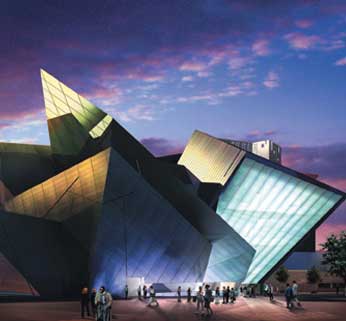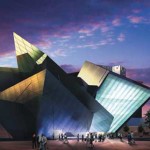The Frederic C. Hamilton building at the Denver Art Museum opened with much fanfare only a few weeks ago. Designed by World Trade Center architect Daniel Libeskind, the new building is a tour de force of architectural structure and spectacle. Many are already claiming it the “most important building” in the last 25 years and without question, the impressive contemporary collection of DAM is housed very beautifully in its new home.
More than any other time in American history museum expansion is seeing a boom. Portland, Boston, Milwaukee, Cincinnati, not to mention the new Modern and New Museum in NYC, have all seen major expansions in the last few years. Spectacular (Guy Debord would be discouraged), sensational, expensive, lots of jutting angles and a sincere lack of conformity towards Modernism all define these buildings. While each of these projects deserves their respective considerations what they each share is the drive to define a city, to symbolize it and make it “contemporary.” On the heels of Frank Gehry’s Guggenheim Balboa, much of this spectacle building has as to do with building capital as it does with seeing art. Indeed, as Hal Foster has articulated extensively in “Design and Crime”, the perversity of this architecture is how the image, or the sign, of the museum is made exchangeable and circulates to generate currency for a city desperate to re-image itself.
In Foster’s most scathing moments he laments that the building’s placement and relationship to its surroundings is rarely taken into account, but is rather a product from a brand name architect that could be plopped anywhere (The most brutal example of this is Gehry’s Experience Music Project in Seattle, where the brand of Gehry sits totally divorced from its surroundings). This brand is then photographed and imaged with the name of the city and circulates internationally. Denver certainly fits this formula as Libeskind’s titanium angles are paired with “Denver” on banners all across town, in print and elsewhere. One needs only to pick up an Artforum, or any other art rag for that matter, to see the new image of Denver.
Which isn’t to say spectacle building does not have sublime moments. The vast openness and winding atrium of the Hamilton building is reminiscent of Frank Lloyd Wright’s Guggenheim New York, but where Wright poetically winds a body through space with gentle slopes and subtlety, Libeskind confronts each viewer with jutting angles and disorienting space. Indeed, nowhere in this atrium is a straight vertical wall and trite as it is to say, the experience is truly contemporary.
The opening exhibition was a peculiar show called “Radar.” Pulled from the collections of Vicki and Kent Logan, the show gets its title from the couple’s uncanny ability to know and define what is happening in the current contemporary moment... as if by radar! Special abilities aside, the exhibition does have some impressive works. Usual suspects Damien Hurst and Takasha Murakami are represented well, as is the well respected but less sensational Michael Joo and the late Michel Majerus. While seeing the art world through the lens of a collector can be valuable, this can often lead to horrendous exhibitions (remember “The Things I Love” at the MFA?).
It should come as no surprise that the Logan’s donated many of the fine works in the DAM collection. While their philanthropy should be applauded, why are they curating shows? “Radar” has few cohesive themes and while it is valuable to see the many impressive works, the organization is more fashion than scholarly or critical. The radar is simply on who is “hot”, or trendy, rather than how groups of works might define our cultural moment. Perhaps this is the cost of spectacle architecture: A museum’s mission becomes decided by who pays for it.
Links:
Denver Art Museum
"Radar" is on view through July 15th in the Anschutz Gallery at the Denver Art Museum.
All images are courtesy of the Denver Art Museum.






